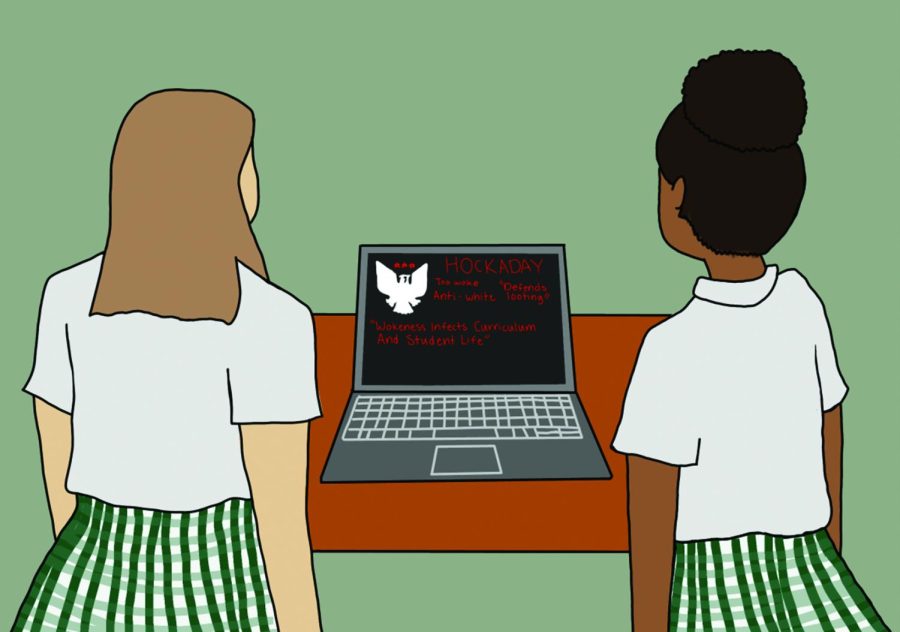Irresponsible journalism
Lindquist’s writing exemplifies risk bad journalism poses
May 10, 2022

Arts & Life Editor
All journalists have a responsibility to present factual and clear evidence, and denial of that responsibility presents a dangerous possibility. In early March, Spencer Lindquist, a senior at Pepperdine University, president of the college’s Republicans club and an intern at The Federalist, published an article about Hockaday. In his article, he makes claims about the school’s policies and resources without clear evidence, exemplifying what I believe to be dangerous and poor journalism.
Early on in the article, Lindquist states the Engineering for US All (E4USA) curriculum material that was used in our physics classes was focused on “left-wing indoctrination.” E4USA is a nationwide program that offers resources to teach the principles of engineering.
When I looked into this claim, I could find no evidence on E4USA’s website or on the Internet supporting his statement.
“We used the E4USA curriculum as part of our physics curriculum for two years, and no longer use it because it wasn’t a good fit,” Dr. Leathers, the Assistant Head of School for Academic Affairs, said.
She said the school had wanted to use the program as a means of integrating both engineering and physics but had not been able to focus on the physics concepts as much as they wanted.
Having taken the physics course my freshman year, I agree with Hockaday’s reason for no longer using the material but also recall there was no mention of any political subject or so-called “left-wing indoctrination.”
Therefore, with both personal experience with the program and a simple amount of research, I find Lindquist’s claim that E4USA’s material is politically motivated is nothing more than a baseless accusation.
He also mentions Hockaday’s affiliation with the National Association of Independent Schools, which he dubs a “far-left” organization trying to “push left-wing racial grievance policies.” However, when I investigated the claim further, looking into the educational and administrative resources they provide, I found nothing supporting these claims.
The NAIS is an organization that provides resources on many different topics, from information about hiring new teachers to mental health awareness, to over 1,600 independent schools across the United States. NAIS has not indicated any political alignment on their website or to involved schools.
Again, with a little research, I am led to believe that another of Lindquist’s statements falls far short of being factual.
Journalism is defined by the American Press Institute as the act of “presenting news and information,” outlining the primary responsibility of a journalist’s job.
Lindquist is spreading misinformation through his work by including baseless claims with no evidence to support his words. There are numerous more statements throughout the article that have no factual grounding, so I encourage those of you who read his article – and any other journalistic work – to read critically and conduct further research of your own.
Additionally, Lindquist includes several unrelated and seemingly off-handed remarks about Hockaday’s policies in his article. For example, he writes, “The Hockaday School, which recently abolished a century-old tradition of white graduation dresses in the name of inclusion, lists a number of different DEI resources on their website.”
I find this to be an unethical, irresponsible addition to his story, as the comment is completely unrelated to the subject of his report and is likely only included to incite explosive reactions from his readers.
Journalists have a responsibility and moral obligation attached to their work, as words have an impact on how people think and feel. However, I believe Lindquist’s portfolio of numerous articles of similar quality rejects this responsibility as the articles reveal his need to grab readers’ attention using low-quality, quickly produced reports.
This article and several of Lindquist’s other works are perfect examples of the danger of irresponsible journalism, and how such articles have the ability to elicit eruptive responses as they are focused more on sensationalism and gaining attention than providing factual information.






Randall Dunn
Sep 10, 2022 at 7:40 am
Great article, Bennett.